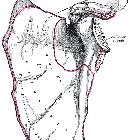Scapula









The scapula (plural: scapulae) is a roughly triangular shaped bone of the pectoral girdle with several articulations connecting to the humerus and clavicle.
Gross anatomy
Osteology
The main part of the scapula, the body, consists of a somewhat triangular-shaped flat blade, with an inferiorly pointing apex, referred to as the inferior angle as well as lateral and superior angles. The scapula is described as having superior, medial, and lateral borders.
Posteriorly, the scapula is divided into a supraspinous fossa and infraspinous fossa by the scapular spine. Anteriorly, on the costal surface, is the shallow subscapular fossa.
Laterally is the glenoid fossa, anteriorly is the coracoid process and superiorly is the acromion that is continuous with the scapular spine and arcs anteriorly over the humeral head. The suprascapular notch lies immediately medial to the base of the coracoid process. The spinoglenoid notch lies posteriorly behind the neck.
Articulations
- acromion: clavicle (forming the acromioclavicular joint)
- glenoid cavity: humeral head (forming the glenohumeral joint)
Attachments
Musculotendinous
- supraspinous fossa: supraspinatus muscle
- infraspinous fossa: infraspinatus muscle, teres minor muscle
- subscapular fossa: subscapularis muscle, serratus anterior
- transverse scapular ligament and adjacent superior border of blade: inferior belly of omohyoid
- acromion: acromial part of deltoid muscle, trapezius
- scapular spine: spinous part of deltoid muscle, trapezius
- coracoid process: coracobrachialis, pectoralis minor, short head of biceps muscle
- lateral border (margo lateralis): teres minor muscle, teres major muscle
- vertebral border (posterior): levator scapulae, rhomboid minor muscle, rhomboid major muscle
- inferior angle: teres major muscle, a small slip of latissimus dorsi
- supraglenoid tubercle: long head of biceps muscle
- infraglenoid tubercle: long head of triceps muscle
Ligamentous
- transverse scapular ligament: crosses suprascapular notch, with the suprascapular nerve below (within the resulting foramen) and the suprascapular vessels above
- coracoacromial ligament
- coracoclavicular ligament
- coracohumeral ligament
- glenohumeral ligaments: upper, middle, and lower bands
- acromioclavicular ligament (weak)
Blood supply
The scapula is surrounded by an arterial anastomosis, the scapular anastomosis which aims to ensure an adequate supply of blood to the upper limb, but has added benefit of adequate supply to the bone itself. It consists of the:
- suprascapular artery
- dorsal scapular artery
- branches of subscapular artery (i.e. circumflex scapular artery)
Variant anatomy
- Sprengel deformity
- os acromiale
- tubercle of Luschka
- unfused coracoid process
Development
See "ossification centers of the pectoral girdle" for information on the scapular ossification centers.
Related pathology
- scapular fracture
- coracoid process fracture
- Bankart lesion
- acromioclavicular joint injury
- osteochondroma
- giant cell tumor
- aneurysmal bone cyst
- chondrosarcoma
- osteosarcoma
- Ewing's sarcoma
- multiple myeloma
- metastasis
- paget disease
Fun fact
17 muscles attach to the scapula (in alphabetic order):
Siehe auch:
- Scapulafraktur
- Klavikula
- Tumoren der Skapula
- Morbus Paget der Skapula
- Chondrosarkom der Skapula
- Osteoidosteom der Scapula
- Läsionen der Skapula
und weiter:

 Assoziationen und Differentialdiagnosen zu Scapula:
Assoziationen und Differentialdiagnosen zu Scapula:


